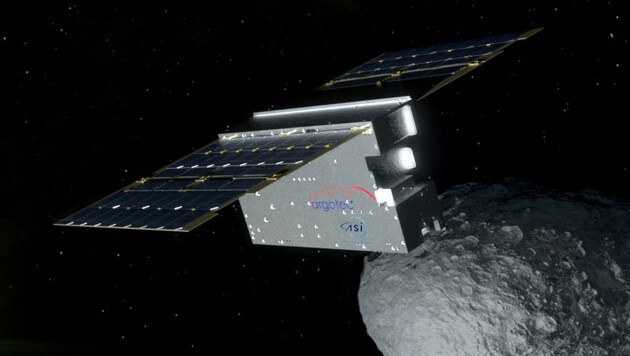29.09.2022
DART IMPACT FROM THE GROUND
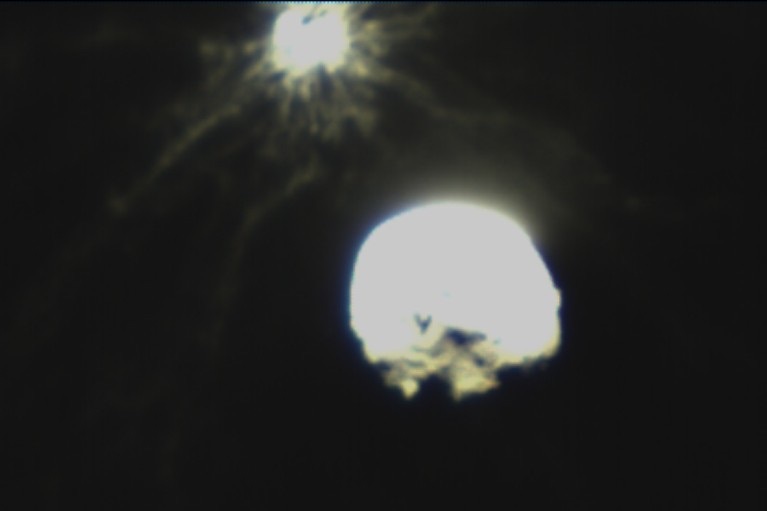
Professionals and amateurs alike were wowed by the dramatic effects of the tiny spacecraft’s crash into the asteroid moon. Not only did the pointlike light from the Didymos system brighten; as astronomers watched, the system shed a crescent-shaped plume of dust, brilliantly illuminated by sunlight. The visible plume didn’t last long, spreading out into invisibility, but the stunning view was captured from numerous locations.
ESA’s Le Makes Observatory in Le Reunion obtained one view of the expanding crescent, but the best images so far came from the Hawai`i-based ATLAS (the Asteroid Terrestrial-impact Last Alert System). Designed to be an early-warning system for near-Earth asteroids approaching Earth, ATLAS scans the entire sky several times a night. Its view of the impact shows the effects in breathtaking detail. At least two separate plumes are visible: one, crescent-shaped, spreads out in the direction opposite to the impact, while another, fainter one jets at an angle behind Didymos’ apparent motion across the sky.

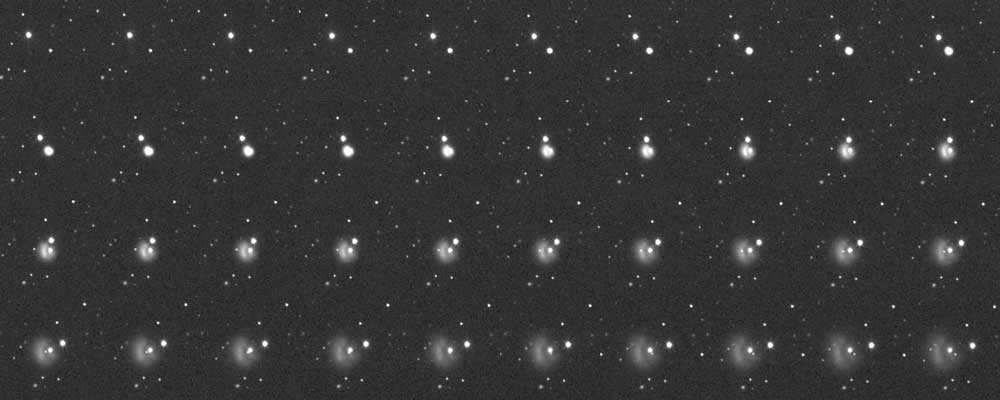
Images: ATLAS Project (University of Hawai`i / NASA); Image processing: Emily Lakdawalla.
Although not as finely detailed, a similar view from the South African Astronomical Observatory’s Lesedi telescope provides long parallax and thus an opportunity for astronomers to study the evolution of the plume in stereo.

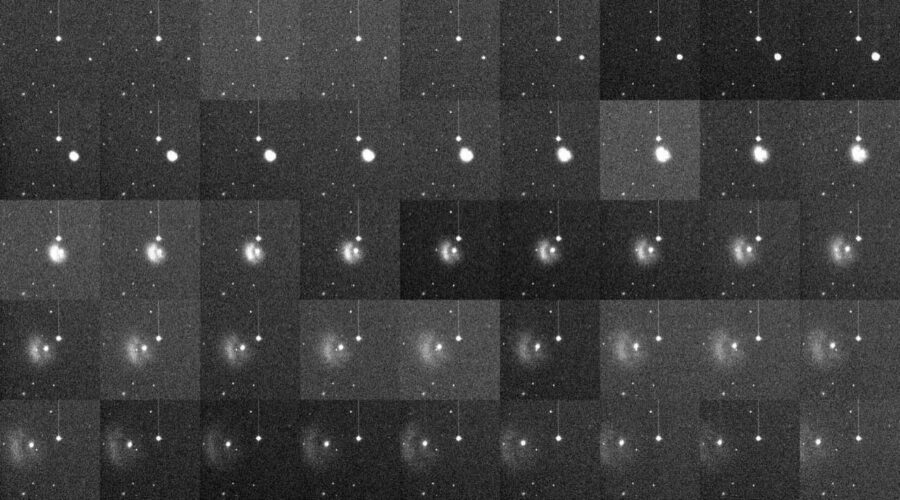
Other ground-based telescopes that captured the impact and shared preliminary versions of their images via Twitter include:
- E. Guido, M. Rocchetto, G. Savini, and S. Fossey at Telescope Live Observatory
- Gianluca Masi and Berto Monard in a collaboration between the Virtual Telescope Project and the Klein Karoo Observatory in Calitzdorp, South Africa
- Tim Lister using a 1-meter telescope operated by Las Cumbres Observatory at SAAO
- Franck Marchis using a Unistellar scope at Reunion Island
- The Turkana Basin Institute’s portable DART – OPTik telescope in northern Kenya
- Eran Ofek and David Polishook from an 11-inch telescope in Israel (a surprisingly good view from such a small telescope!)
In addition, many telescopes were performing spectral observations in order to study the composition of the plume. Those results must await calibration, but it looks like the Infrared Telescope Facility in Hawai`i obtained good data!
DART IMPACT FROM SPACE
In space, both the Hubble and James Webb Space Telescopes were observing, as was the Lucy mission, and preliminary versions of the Webb Near-infrared Camera (NIRCAM) images are already out:
The black dot at center results from the saturation of NIRCAM’s sensitive detector, and the six arms of a symmetrical star around Dimorphos are diffraction spikes in the instrument optics. But the cloud of dust and streaky plumes are debris from the impact, promising great science to come.
And then there are the DART and LICIAcube images: DART revealed Didymos to be smooth in some places, gullied in others. The smoothly bulging equator is reminiscent of Bennu, the asteroid visited by NASA’s OSIRIS-Rex mission, while the gullies look like those on Saturn’s moon Helene. Dimorphos is extremely blocky, like all near-Earth asteroids seen in such detail: Bennu, Itokawa, and Ryugu.
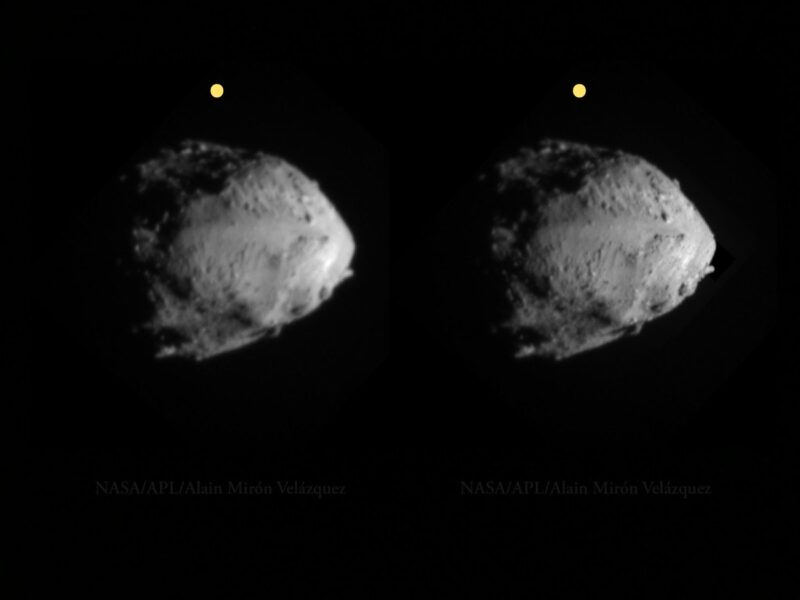
NASA / JHUAPL / Alain Mir
And these are the views the Italian Space Agency released from LICIAcube this morning, taken before the spacecraft’s close (55-kilometer) flyby of Didymos. The photos show a streaky plume expanding in all directions from the CubeSat’s point of view:
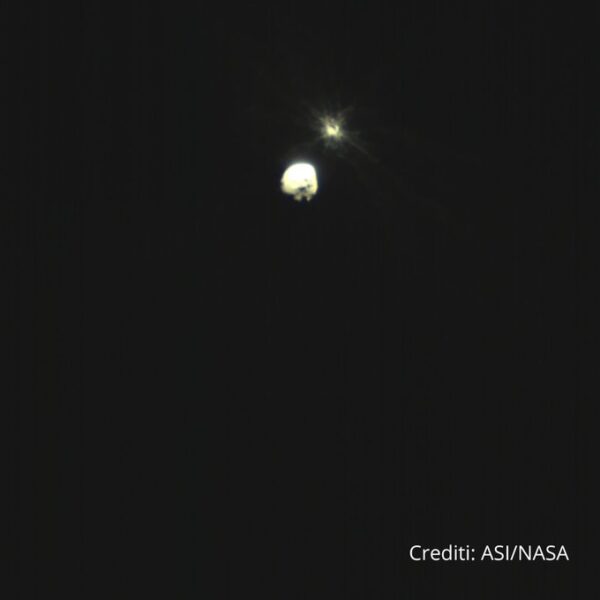
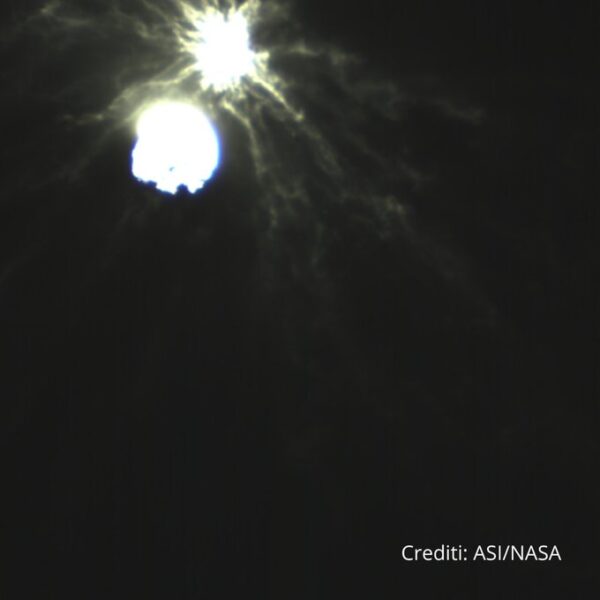
Hundreds more images await download from LICIAcube, and we have yet to see photos from Hubble and Lucy. Professional study of these many images will enable astronomers to generate 4D models of the plume evolving over time and space. A special session at December’s American Geophysical Union meeting will feature the early results from this research, so stay tuned for science!
Quelle: Sky&Telescope
----
Update: 30.09.2022
.
NASA-MISSION DART
Die ersten Fotos vom Einschlag auf dem Asteroiden
Zwei Tage nachdem die US-Raumfahrtbehörde NASA absichtlich eine Sonde in den Asteroiden Dimorphos gelenkt hat, um dessen Bahn zu verändern, sind am Donnerstag mehrere Bilder veröffentlicht worden. Die Aufnahmen, die unter anderem von den Weltraumteleskopen „Hubble“ und „Webb“ sowie von einer Mikrosonde gemacht wurden, zeigen eine gewaltige Wolke aus Staub und Trümmern, die sich nach der Kollision ausbreitete.
„Wir haben bei Dimorphos einen Schaden angerichtet“, wird Patrick Michel von der Europäischen Weltraumagentur ESA, die an der Auswertung des DART-Experiments beteiligt ist, zitiert. Das Volumen des beim Aufprall der Sonde ins Weltall geschleuderten Materials sei „ziemlich unglaublich“, so der Wissenschaftler.
Auch das Asteroiden-Warnsystem ATLAS (Asteroid Terrestrial-impact Last Alert System) veröffentlichte ein Zeitraffer-Video des Manövers. Es wurde aus Einzelbildern seines Teleskops in Südafrika, das alle 40 Sekunden eine Aufnahme machte, zusammengesetzt. Die gesamte Sequenz dauert demnach rund zwei Stunden (siehe Video unten).
„Staubwolke so groß wie die Erde“
Angaben von Experten zufolge hat die DART-Sonde bei ihrem Aufprall eine „sehr, sehr große Staubwolke“ erzeugt. Diese habe einen Durchmesser von mehreren Tausend Kilometern gehabt, heißt es. Laut dem Astronomen John Tonry von der Universität von Hawaii ist man von der Größe der Staubwolke um Dimorphos überrascht. Damit habe er nicht gerechnet, wird der Forscher in der „New York Times“ zitiert. „Innerhalb einer Stunde war die Wolke so groß wie die Erde“, so der Experte.
Auch die Mikrosonde LICIAcube (Light Italian CubeSat for Imaging of Asteroids) der italienischen Raumfahrtbehörde ASI funkte Bilder vom Einschlag zur Erde. Sie wurden einige Minuten nach der Kollision in der Nacht auf Dienstag aufgenommen. Die Sonde (Bild unten), die mit DART ins All geflogen und am 11. September abgekoppelt worden war, flog wenige Minuten nach der Kollision im Abstand von knapp 60 Kilometern an Dimorphos vorbei und machte Aufnahmen.
Minisonde fotografiert aufgewirbeltes Material
Auf den Schwarz-Weiß-Fotos sind deutlich Helligkeitsunterschiede sowie eine Wolke aus aufgewirbeltem Material zu erkennen. „Hier sind die ersten von LICIACube aufgenommenen Bilder der Auswirkungen der DART-Mission auf Dimorphos. Jetzt beginnen Wochen und Monate harter Arbeit für die Wissenschaftler und Techniker, die an dieser ersten planetaren Verteidigungsmission beteiligt sind, also bleiben Sie in Verbindung!“, twitterte die ASI.
Auch die Weltraumteleskope „Hubble“ und „James Webb“ wurden auf Dimorphos gerichtet. Ein auf der ESA-Website veröffentlichte Animation von Einzelbildern zeigt in Zeitraffer die Nachwirkungen des Double Asteroid Redirection Test (DART). Die Animation umfasst den Zeitraum kurz vor dem Aufprall der Sonde bis zu fünf Stunden nach dem Aufprall. Materialwolken aus einem kompakten Kern erscheinen als Strähnen, die von der Stelle wegströmen, an der die Sonde einschlug. Auf den Aufnahmen ist auch ein Bereich mit schneller, extremer Aufhellung sichtbar.
Staubwolke wird auf Asteroiden zurückfallen
Die Bestandteile der gewaltigen Wolke aus sich langsam bewegenden Trümmern und Staub, die in der Nähe der Asteroiden Didymos und Dimorphos verbleibt, werden in den kommenden Wochen auf die Oberflächen der beiden Himmelskörper zurückfallen, so die Experten. Anhand der Staubwolke könne man nun Schätzungen zur Dichte der Oberfläche von Dimorphos anstellen, heißt es.
Die DART Sonde war in der Nacht auf Dienstag wie geplant auf der Oberfläche des Asteroiden Dimorphos aufgeschlagen. Laut Angaben der NASA-Forscher handelt es um einen ersten vorsichtigen Versuch, ob es möglich sein könnte, die Flugbahn eines Asteroiden auf diese Weise abzuändern. Man erhofft sich von der Mission Erkenntnisse darüber, wie die Erde vor herannahenden Asteroiden geschützt werden könnte.
Aufprall soll die Umlaufbahn verändern
Nach dem Aufprall soll die rund zwölfstündige Umlaufbahn von Dimorphos um mindestens 73 Sekunden und möglicherweise bis zu zehn Minuten kürzer dauern.
Quelle: Kronen Zeitung

